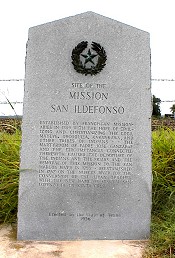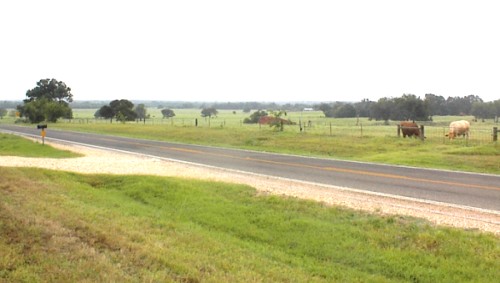| |

 Mission San Ildefonso - The Texas Historical Marker is located on the north side of FM 908, west of County Road 429, north of Rockdale in Milam County, at latitude N 30.69410° and longitude W 97.09383° Mission San Ildefonso - The Texas Historical Marker is located on the north side of FM 908, west of County Road 429, north of Rockdale in Milam County, at latitude N 30.69410° and longitude W 97.09383°

Click for larger image

View from the marker towards the east
 The Mission San Ildefonso, also known as San Francisco Xavier de Horcasitas Mission, was the second of the three San Xavier missions founded along the San Gabriel (known then as San Xavier) River. Today the exact site is not known, as there are two elevations above the junction of the San Gabriel River and Brushy Creek, and either could have been the site of Ildefonso. Ildefonso was founded by the College of Santa Cruz de Querétaroq through the work of Father Mariano Francisco de los Dolores y Viana (Father Dolores). This was part of the vast plan of the church for settlement of the Spanish all over what would become Texas. It was begun on December 27, 1748, and formally established on February 25, 1749. The Mission San Ildefonso, also known as San Francisco Xavier de Horcasitas Mission, was the second of the three San Xavier missions founded along the San Gabriel (known then as San Xavier) River. Today the exact site is not known, as there are two elevations above the junction of the San Gabriel River and Brushy Creek, and either could have been the site of Ildefonso. Ildefonso was founded by the College of Santa Cruz de Querétaroq through the work of Father Mariano Francisco de los Dolores y Viana (Father Dolores). This was part of the vast plan of the church for settlement of the Spanish all over what would become Texas. It was begun on December 27, 1748, and formally established on February 25, 1749.
 Located on the south bank of the San Gabriel River (then known as the San Xavier River) near the mouth of today's Brushy Creek (Arroyo de las Animas) about five miles from the site of present-day Rockdale in Milam County, Ildefonso was home to Akokisa (Orocquisa), Bidai, and Deadose Indians, who spoke a similar dialect and intermarried. Located on the south bank of the San Gabriel River (then known as the San Xavier River) near the mouth of today's Brushy Creek (Arroyo de las Animas) about five miles from the site of present-day Rockdale in Milam County, Ildefonso was home to Akokisa (Orocquisa), Bidai, and Deadose Indians, who spoke a similar dialect and intermarried.
 Because the requested presidio to protect the missions was not started at the same time, the supply trains were often attacked along the way, or simply never left the safety of the San Antonio missions to deliver their goods. When the mission ran out of food the soldiers and missionaries were forced to trade with the Indians for supplies. The missionaries claimed this undermined their authority with the new converts. Additionally, reports that were supposed to be sent to the Auditor of the Church were not sent due to illness and accidents. Father Mariano eventually suffered an accident that sent him back to San Antonio. Because the requested presidio to protect the missions was not started at the same time, the supply trains were often attacked along the way, or simply never left the safety of the San Antonio missions to deliver their goods. When the mission ran out of food the soldiers and missionaries were forced to trade with the Indians for supplies. The missionaries claimed this undermined their authority with the new converts. Additionally, reports that were supposed to be sent to the Auditor of the Church were not sent due to illness and accidents. Father Mariano eventually suffered an accident that sent him back to San Antonio.
 In March of 1749, Father Mariano reported a total of ninety six Bedais and fifty-five Deadose Indians. A group of Coco Indians was also gathered here awaiting establishment of Mission Candelaria, but they fled the establishment because of harassment from soldiers sent to protect the missions. Father Benito went after them alone to persuade them to return because they were suffering from measles and smallpox. No soldiers would go with Father Benito, who managed to return with eighty-two Coco. But, the remaining Indians, unable to adjust to sedentary mission life, left the mission in October 1749. In March of 1749, Father Mariano reported a total of ninety six Bedais and fifty-five Deadose Indians. A group of Coco Indians was also gathered here awaiting establishment of Mission Candelaria, but they fled the establishment because of harassment from soldiers sent to protect the missions. Father Benito went after them alone to persuade them to return because they were suffering from measles and smallpox. No soldiers would go with Father Benito, who managed to return with eighty-two Coco. But, the remaining Indians, unable to adjust to sedentary mission life, left the mission in October 1749.
 Missionaries managed to re congregate the Indians by the time of Capt. José Joaquín de Ecay Múzquiz's visit in 1750. They reported baptizing 150 souls and bringing them into the church, which was a major requirement of the church for the existance of the missions. Shortly after the captain's inspection the Indians abandoned Ildefonso to join their allies in a campaign against the Apaches. The missionary in charge of San Ildefonso, Father Juan José Ganzabal, was killed at Mission Candelaria in 1752. Missionaries managed to re congregate the Indians by the time of Capt. José Joaquín de Ecay Múzquiz's visit in 1750. They reported baptizing 150 souls and bringing them into the church, which was a major requirement of the church for the existance of the missions. Shortly after the captain's inspection the Indians abandoned Ildefonso to join their allies in a campaign against the Apaches. The missionary in charge of San Ildefonso, Father Juan José Ganzabal, was killed at Mission Candelaria in 1752.
 This murder of a priest by soldiers did much to destroy the morale of both the missionaries and the soldiers of all the San Xavier missions. When the Bidais Indians attempted to to return to the mission in 1753, the fathers sent them back to their lands because the mission lacked enough supplies to keep them. In August 1755 conditions at the site forced the population of missions and the presidio (which had finally been begun in July 1749) to withdraw to the San Marcos River. In 1756 the property of San Ildefonso Mission was transfered to Santa Cruz de San Sabá Mission This murder of a priest by soldiers did much to destroy the morale of both the missionaries and the soldiers of all the San Xavier missions. When the Bidais Indians attempted to to return to the mission in 1753, the fathers sent them back to their lands because the mission lacked enough supplies to keep them. In August 1755 conditions at the site forced the population of missions and the presidio (which had finally been begun in July 1749) to withdraw to the San Marcos River. In 1756 the property of San Ildefonso Mission was transfered to Santa Cruz de San Sabá Mission
 BIBLIOGRAPHY: Herbert Eugene Bolton, Texas in the Middle Eighteenth Century (Berkeley: University of California Press, 1915; rpt., Austin: University of Texas Press, 1970). Kathleen K. Gilmore, The San Xavier Missions: A Study in Historical Site Identification (State Building Commission Report 16, Austin, 1969). Mary Belle Batte, Spanish Missions of Milam County 1746-1756 (Cameron: Milam County Historical Museum, 1999). BIBLIOGRAPHY: Herbert Eugene Bolton, Texas in the Middle Eighteenth Century (Berkeley: University of California Press, 1915; rpt., Austin: University of Texas Press, 1970). Kathleen K. Gilmore, The San Xavier Missions: A Study in Historical Site Identification (State Building Commission Report 16, Austin, 1969). Mary Belle Batte, Spanish Missions of Milam County 1746-1756 (Cameron: Milam County Historical Museum, 1999).

|
|

